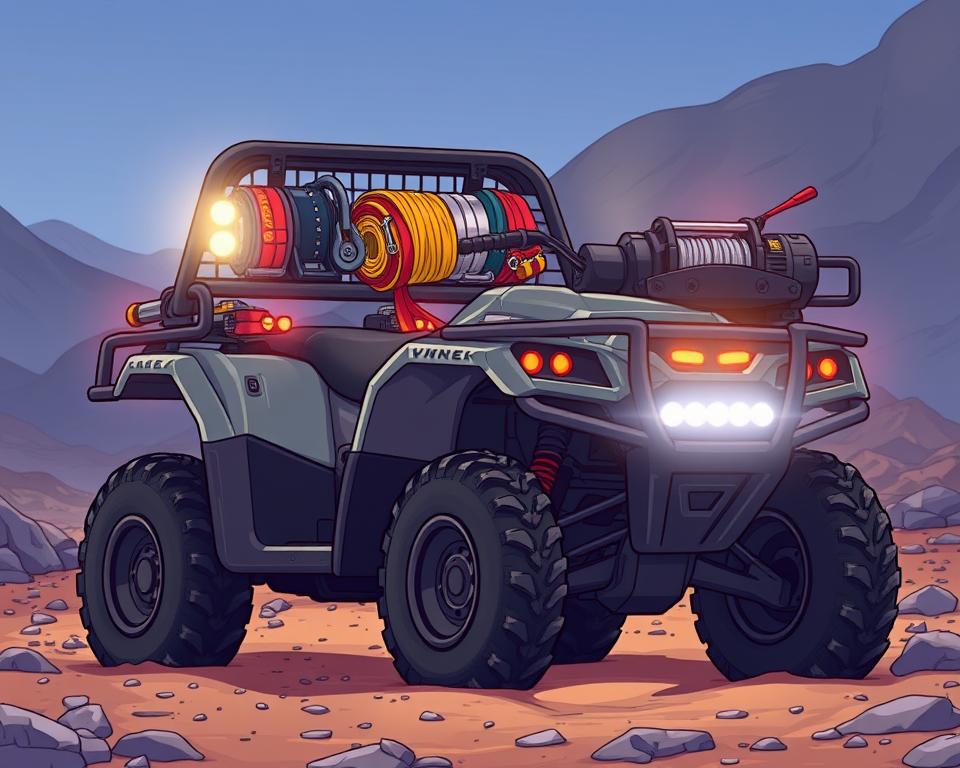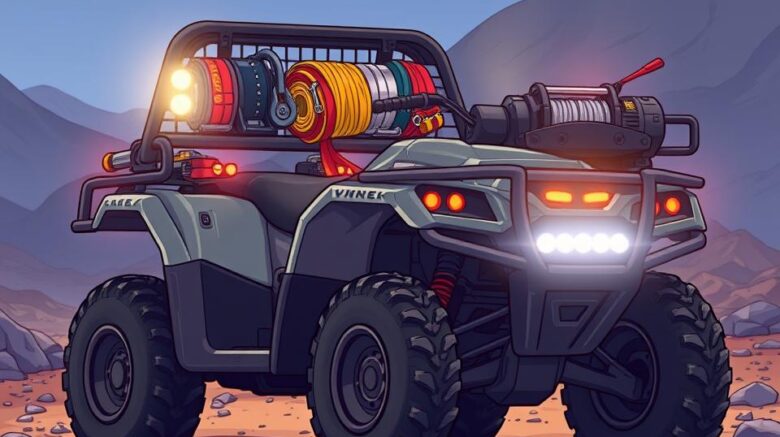Must-Have ATV Off-Road Safety Checklist
It might surprise you to discover nearly 450,000 ATV-related injuries are treated in U.S. emergency rooms each year? This alarming figure highlights the need for safety and preparedness in off-road adventures. Here’s your go-to ATV Off-Road Checklist for maximum safety and enjoyment. It covers everything from rocky trails to sand dunes. With the right safety gear and Honda pioneer 500 lift essentials, you can minimize risks and boost your adventure.
Summary Highlights
- Start with safety: follow this checklist for full prep.
- Don’t hit the trail without this ATV safety gear list.
- Regular maintenance is key to keep your ATV in top shape.
- Hydration and nutrition boost endurance and focus on long rides.
- Learn to use navigation tools to avoid getting lost on off-road routes.
- Weather can flip fast—be ready with proper gear.
- Trailside fixes? Have your toolkit and recovery gear ready.
Understanding the Importance of Safety Gear
When you ride off-road, safety must come first. The excitement of ATVs brings potential hazards. Proper gear guards you against mishaps. Gear up correctly with this ATV safety gear checklist.

Essential Protective Gear
Maximizing protection involves several key items:
- Riding Helmets: Always use a DOT helmet to guard against head trauma.
- Goggles: Protect your vision with wraparound goggles.
- Gloves: Gloves help you hold on and protect your skin.
- Footwear: Ankle-support boots are a must.
- Body Armor: Wear armor to guard your torso on rough trails.
- Neck Braces: A neck brace protects your spine in a crash.
Emergency Preparedness
Being ready for emergencies is critical. An effective emergency kit can be a lifesaver in unexpected situations. Key items to include are:
- First aid kit
- Multi-tool
- Tire repair kits
- Portable air compressors
- Emergency blankets
- Whistles
- Matches
ATV Equipment for Optimal Performance
Gear choices affect how well your ATV runs. Pack these essentials for any trail. Routine checks keep your ATV working its best.
Must-Have ATV Equipment
- Durable Tires: Choose tires that grip mud, sand, and rocks.
- Cargo Systems: Keep tools and spares within reach.
- Quality Fuel Tank: Never run low—use a proven fuel tank.
- Medical Kit: Stock your kit with bandages, antiseptic, and meds.
Regular Maintenance for Longevity
A maintenance schedule is your ATV’s best friend. Regular inspections should encompass:
- Inspect and clean or replace air filters regularly.
- Lubricating the chain to ensure optimal performance.
- Test your brakes on every pre-ride check.
This ATV maintenance checklist is essential for keeping your vehicle in peak condition and ready for adventure.
The Essential ATV Off-Road Checklist
Don’t skip your pre-ride safety scan. An effective ATV maintenance checklist ensures your vehicle’s safety and performance. Every point matters—don’t rush. A thorough pre-ride assessment is key to a safe outing.
Pre-Ride Inspection Basics
Before any off-road journey, a pre-ride inspection is vital. This quick evaluation helps riders identify and address issues before they start. Key elements to check include:
- Tire pressure and tread condition
- Fluid levels such as oil and fuel
- Brakes and controls functionality
- Operational lights and horn
- Chain or driveshaft integrity
T-CLOC Inspection Method
The T-CLOC method offers a systematic approach to inspection. Tires, Controls, Lights, Oil/Fuel, Chain—don’t miss a spot. This method ensures all critical areas are covered:
| Inspection Area | Checklist Items |
|---|---|
| Tires and Wheels | Check tire pressure, inspect tread depth, look for damage |
| Controls | Test brakes, throttle, and clutch for smooth operation |
| Lights | Ensure headlights, brake lights, and indicators are functioning |
| Oil and Fuel | Check oil level, inspect for leaks, and fill fuel tank |
| Chain/Driveshaft | Examine for wear, proper tension, and lubrication |
Check everything—ride with confidence. By checking these essential components, riders can avoid breakdowns.
Hydration and Nutrition for Long Rides
Stay fueled and hydrated for peak performance. Riders often underestimate their fluid needs, making it essential to plan ahead. Water packs help maintain endurance and alertness. Nutritious snacks power you through rough stretches.
Importance of Staying Hydrated
Hydration is critical for ATV riders to stay alert and capable throughout their journey. A hydration pack with sip tube makes it easy. Hydration bladders track consumption at a glance.
High-Energy Snacks to Pack
The right fuel makes the ride smoother. Opt for non-perishable items that are easy to consume. Some ideal choices include:
- Protein bars
- Nut mixes
- Dried fruits
- Beef jerky
Snack smart for sustained energy. Ensure to pack a variety to keep your energy levels high and your taste buds satisfied.
Navigation Tools for Off-Roading Adventures
Exploring uncharted territory demands reliable navigation tools. A dependable nav setup means you’ll always find your way.
Advanced GPS Systems
An advanced GPS system is a must for off-road adventures. Look for features like offline maps and a long-lasting battery. Brands like Garmin and TomTom offer models designed for off-road use, ensuring durability and precision.
Traditional Navigation Aids
Don’t ditch old-school compasses and maps. A compass never needs a signal. Wind your own way with map and compass skills. Blend modern and classic for ultimate wayfinding.
Communication Equipment for Safety
Effective communication is key during off-road adventures, as many trails are in remote areas with no cell service. Clear comms keep your group coordinated. Knowing you can call for help reduces stress.
Don’t split up without radios in hand. Pick units with strong, clear signal range. Get instant alerts about obstacles ahead. When choosing two-way radios, look for models with:
- Weatherproof construction to resist the elements
- Long battery life for extended trips without needing a recharge
- Channel selection for clear communication without interference
Adding ATV communication gear to your adventure prep is essential. These tools improve interaction among riders and boost safety. Radios cut through noise and barriers. With the right tools, your off-road trips will be smoother and more enjoyable.
Self-Rescue Gear for ATV Riders
Every ATV rider should be ready for unexpected situations on the trail. Relying on yourself starts with proper rescue tools. Being self-sufficient elevates confidence and safety.
Winches and Recovery Kits
A winch can drag you out of any rut. Kit up your winch for maximum extraction muscle. Recovery kits usually include:
- Tow straps
- D-rings
- Recovery boards
- Gloves
Knowledge plus gear equals true self-rescue. Don’t let stuck wheels end your ride.
Trail Recovery Essentials
Your toolbox should extend beyond the winch. These include:
| Equipment | Purpose |
|---|---|
| Recovery Straps | Used for towing or pulling ATVs out of tight situations. |
| Shovel | Helps clear obstacles and dig out vehicles when stuck. |
| Traction Mats | Provides grip under tires in muddy or slick conditions. |
| Portable Air Compressor | Enables quick tire inflation after deflating for better traction. |
Be the rider who never gets stranded. Knowing how to use these tools greatly improves safety and adventure on your off-road excursions.
Staying Adaptable: Preparing for Weather Changes
Weather variability is a major challenge in off-roading. Be prepared for sun, rain, or wind at any moment. Pack for every possible forecast.
Layer up, shed as needed. Start with wick-away fabrics. Fleece or wool gives you warmth on demand. Your shell fights off wind and rain. This setup ensures you stay comfortable, no matter the weather.
Weather-Appropriate Clothing
- Rain Shells: Stay dry when the sky opens up.
- Ventilated Off-Road Pants: Pants that vent yet keep out the rain.
- Sun Protection: Lightweight, long-sleeved shirts and wide-brimmed hats safeguard against harmful UV rays.
- Cold-Weather Gloves: Insulate your hands against cold snaps.
Gear up for every climate challenge. Comfortable riders ride longer and safer.
Tools for On-Trail Repairs
Your toolkit can make or break your day on the trail. Pack tools you trust. These tools help address minor breakdowns or issues that may arise during your adventure.
Must-Have Tools and Kits
No ride is complete without a toolkit. This kit should include essential items for quick repairs. Critical ATV repair tools might include:
- Tire irons for changing flat tires
- Pliers for gripping and cutting
- Wrenches for various sizes of bolts and nuts
- A multi-tool for versatility
- Spare items such as spark plugs and electrical wire
- Duct tape for quick fixes
Tools at hand mean no surprises.
Basic Emergency Supplies
Tools alone won’t save you—bring these extras. These supplies help ensure your safety in challenging situations:
- First aid kit for injuries
- Flashlight with extra batteries for night-time visibility
- Emergency whistle for signaling assistance
- Reflective triangles or flares to warn other riders
- Water and high-energy snacks for sustenance
Preparation pays off big time. Always keep these ATV repair tools and emergency supplies handy.
Wrapping It Up
Success and enjoyment in off-road adventures depend on thorough preparation. Follow this checklist and choose quality gear. Be set for rocks, sand, mud—anything.
Load up on safety, navigation, and comms gear. Prep wisely for peak thrills and protection. It lets you enjoy the thrill of off-road adventures without worry.
Gear up, stay sharp, and savor every off-road second. The journey is as important as the destination. Use this guide for the best off-road experiences.
FAQ
What must an ATV safety checklist cover?
Your ATV safety gear checklist should include a DOT-approved helmet and goggles. Add gloves, boots, and torso protection. Consider a neck brace for extra safety. Remember to pack an emergency kit with a first aid kit and multi-tools for preparedness.
How can I ensure my ATV is well-maintained?
Keep filters clean and chain well-lubed. Don’t ignore brake checks. A consistent maintenance routine extends your machine’s life and keeps it ready for off-road adventures.
What is included in T-CLOC?
The T-CLOC inspection method covers several key areas. It includes checking Tires and Wheels, Controls, Lights, Oil and Fuel, and Chain/Driveshaft. This ensures your ATV’s critical components are in working order before hitting the trails.
How to gauge water needs off-road?
Pack extra hydration for safety. Stay topped off to avoid dehydration. Hydro packs let you drink without stopping.
What should I bring for navigation during my off-road adventure?
For navigation, invest in an advanced GPS system designed for off-road use. Combine this with traditional aids like waterproof maps and compasses.
Why is communication important when off-roading?
Effective communication is vital for safety and reassurance during off-road adventures. In no-signal zones, radios shine.
What self-rescue gear should every ATV rider carry?
Pack a winch plus full recovery gear. This kit should include tow straps, D-rings, and recovery boards.
Tips for weather readiness off-road?
Use a base, mid, and shell layering system. Pack a rain shell to stay dry. Wear sun-blocking fabrics and hats.
Which trailside tools matter most?
A compact tool set lets you fix flats and loose bolts. Have spares and tape for quick fixes.
